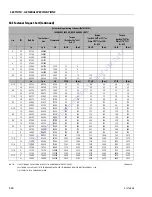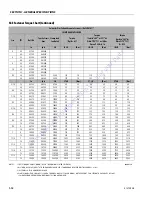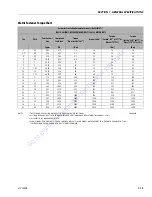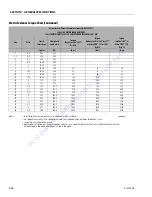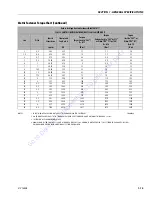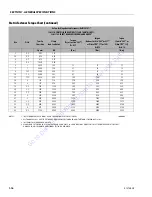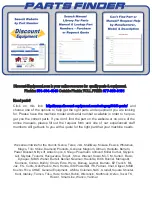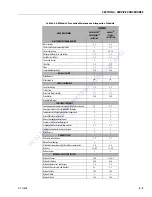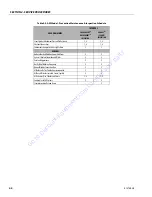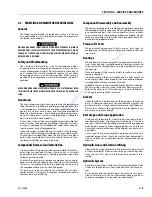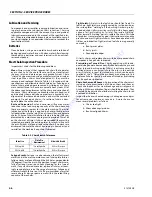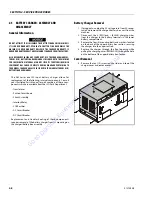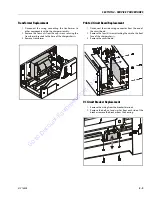
SECTION 2 - SERVICE PROCEDURES
31215808
2-5
2.3
SERVICING AND MAINTENANCE GUIDELINES
General
The following information is provided to assist you in the use
and application of servicing and maintenance procedures
contained in this chapter.
WHEN AN ABNORMAL CONDITION IS NOTED AND PROCEDURES CONTAINED
HEREIN DO NOT SPECIFICALLY RELATE TO THE NOTED IRREGULARITY, WORK
SHOULD BE STOPPED AND TECHNICALLY QUALIFIED GUIDANCE OBTAINED
BEFORE WORK IS RESUMED.
Safety and Workmanship
Your safety, and that of others, is the first consideration when
engaging in the maintenance of equipment. Always be con-
scious of component weight. Never attempt to move heavy
parts without the aid of a mechanical device. Do not allow
heavy objects to rest in an unstable position. When raising a
portion of the equipment, ensure that adequate support is
provided.
NEVER WORK UNDER AN ELEVATED PLATFORM UNTIL PLATFORM HAS BEEN
SAFELY RESTRAINED FROM ANY MOVEMENT BY BLOCKING OR OVERHEAD
SLING.
Cleanliness
The most important single item in preserving the long service
life of a machine is to keep dirt and foreign materials out of the
vital components. Precautions have been taken to safeguard
against this. Shields, covers, seals, and filters are provided to
keep the wheel bearings, mast sections and oil supply clean;
however, these items must be maintained on a scheduled
basis in order to function properly.
At any time when oil lines are disconnected, clear adjacent
areas as well as the openings and fittings themselves. As soon
as a line or component is disconnected, cap or cover all open-
ings to prevent entry of foreign matter.
Clean and inspect all parts during servicing or maintenance,
and assure that all passages and openings are unobstructed.
Cover all parts to keep them clean. Be sure all parts are clean
before they are installed. New parts should remain in their
containers until they are ready to be used.
Components Removal and Installation
Use adjustable lifting devices, whenever possible, if mechani-
cal assistance is required. All slings
(chains, cables, etc.)
should
be parallel to each other and as near perpendicular as possible
to top of part being lifted.
Should it be necessary to remove a component on an angle,
keep in mind that the capacity of an eyebolt or similar bracket
lessens, as the angle between the supporting structure and
the component becomes less than 90 degrees.
If a part resists removal, check to see whether all nuts, bolts,
cables, brackets, wiring, etc., have been removed and that no
adjacent parts are interfering.
Component Disassembly and Reassembly
When disassembling or reassembling a component, complete
the procedural steps in sequence. Do not partially disassemble
or assemble one part, then start on another. Always recheck
your work to assure that nothing has been overlooked. Do not
make any adjustments, other than those recommended, with-
out obtaining proper approval.
Pressure-Fit Parts
When assembling pressure-fit parts, use an “anti-seize” or
molybdenum disulfide base compound to lubricate the mat-
ing surface.
Bearings
When a bearing is removed, cover it to keep out dirt and abra-
sives. Clean bearings in nonflammable cleaning solvent and
allow to drip dry. Compressed air can be used but do not spin
the bearing.
Discard bearings if the races and balls (or rollers) are pitted,
scored, or burned.
If bearing is found to be serviceable, apply a light coat of oil
and wrap it in clean (waxed) paper. Do not unwrap reusable or
new bearings until they are ready to install.
Lubricate new or used serviceable bearings before installation.
When pressing a bearing into a retainer or bore, apply pres-
sure to the outer race. If the bearing is to be installed on a
shaft, apply pressure to the inner race.
Gaskets
Check that holes in gaskets align with openings in the mating
parts. If it becomes necessary to hand-fabricate a gasket, use
gasket material or stock of equivalent material and thickness.
Be sure to cut holes in the right location, as blank gaskets can
cause serious system damage.
Bolt Usage and Torque Application
Use bolts of proper length. A bolt which is too long will bot-
tom before the head is tight against its related part. If a bolt is
too short, there will not be enough thread area to engage and
hold the part properly. When replacing bolts, use only those
having the same specifications of the original, or one which is
equivalent.
Unless specific torque requirements are given within the text,
standard torque values should be used on heat-treated bolts,
studs, and steel nuts, in accordance with recommended shop
practices.
Hydraulic Lines and Electrical Wiring
Clearly mark or tag hydraulic lines and electrical wiring, as well
as their receptacles, when disconnecting or removing them
from the unit. This will assure that they are correctly rein-
stalled.
Hydraulic System
Keep the system clean. If evidence of metal or rubber particles
is found in the hydraulic system, drain and flush the entire sys-
tem.
Disassemble and reassemble parts on clean work surface.
Clean all metal parts with non-flammable cleaning solvent.
Lubricate components, as required, to aid assembly.
Go
to
Discount-Equipment.com
to
order
your
parts



